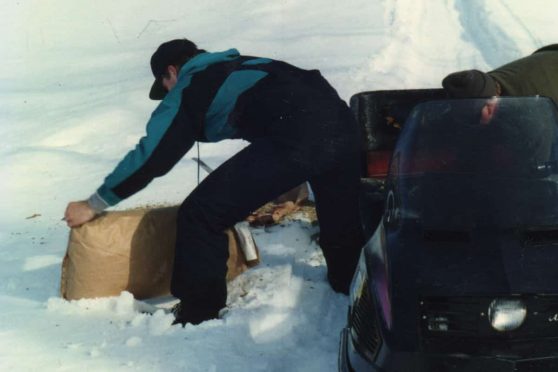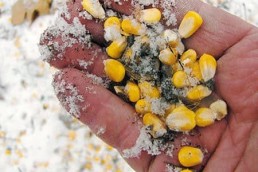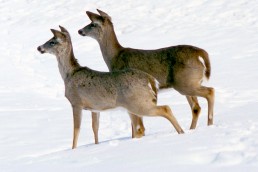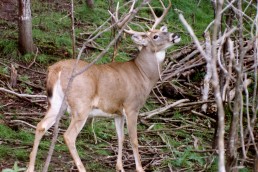How Important is Feeding Whitetails during Severe Winters?
SHARE THIS POST
Each year since the discovery of Minnesota’s changing moose population—waning scientists say, due to brain worms not fatal to whitetails but are to moose—and because of the continuing threat of chronic wasting disease in southeastern Minnesota (fatal to whitetails), it has been decided deer should not be fed by humans in winter because this causes them to congregate, thus increasing exposure and the number of afflicted deer.
It’s difficult to imagine such a measure can actually improve matters. Beginning about the fourth week in December during a typical Minnesota winter—earlier if snow is especially deep—half a million Minnesota whitetails abandon their spring-through-fall home ranges and migrate to traditional wintering areas, or “deer yards,” that provide better cover from snowfall and the frigid winds and provide food (browse) for larger numbers. Whitetails will travel vast distances to reach their winter destinations. Such areas vary greatly in size with some supporting only two dozen deer through winter while other areas can support hundreds, such as the Lutsen wintering area along the north shore of Lake Superior. When snow melts in early spring, the whitetails return to their previously established spring-through-fall home ranges.

What then, do persons who believe whitetails should not be fed in winter because it causes them to congregate, plan to do about the roughly 500,000 Minnesota whitetails or so that annually meet in their wintering areas?
After spending considerable time in the Lutsen wintering area during the past 40-some winters, I’m convinced a law to prevent feeding whitetails can actually do more harm than good. Feeding starving deer late during severe winters does not attract more deer to wintering areas—those that are there arrived in late December. By the time feeding becomes necessary, all other deer are locked by deep snow in the other wintering areas they’ve chosen.
In most areas I have known (some since destroyed by logging), the balance between numbers of deer present and available wild foods is delicate. Though most whitetails (exception of 6 1/2-year-old dominant breeding bucks) store enough fat in the fall to enable them to survive a few weeks without feeding during desperate times, it’s the deepening snow that hides natural browse and needed calories to search for additional food that can tip the balance fairly quickly. When conditions become severe in late winter, whitetails unable to reach high enough in trees to eat remaining browse or greenery of cedars begin to seriously suffer from starvation within two to three weeks. Their stored fat is most used when conditions are so severe that whitetails will decline to move from their beds until the weather improves. This includes blizzard conditions with sustained strong winds producing frigid wind-chill temperatures 20 to 45 degrees below zero.
The question then, of how important is feeding deer during severe winters has to be considered. Almost single-handedly, winter residents living near Lutsen and the west end of Gunflint Lake saved the deer—feeding them hay and alfalfa—that eventually restored whitetail numbers throughout Cook and Lake counties following the two severe winters of the 1960s that practically wiped out all the deer in these counties.
Are you enjoying this post?
You can be among the first to get the latest info on where to go, what to use and how to use it!

During those two harsh winters, my brother Bob and I spent many weekends on snowshoes, using handsaws to cut down trees (white cedars) in northeastern Aitkin County in an attempt to save as many deer suffering from starvation as we could. There were about 100 whitetails in each of the two wintering areas, which is where we spent most of our time. Within an hour or so after those deer first realized what we were doing, many regularly crowded the trails, along which, we sawed down white cedars—the only emergency food then available that they would readily eat. They often devoured all the greenery they could reach on a tree we had cut down before we managed to cut down another. To give them access to parts of dropped trees they couldn’t reach because they were too weak to push through 3 to 4 feet of snow outside of their well-trampled area trails, we often dug new trails for them with our snowshoes.
One disheartening morning after snowshoeing deep into one of these wintering areas we discovered seven dead whitetails that had been killed by wolves. While deer less weakened by starvation—bloody-chinned whitetails tall enough when standing on hind legs to reach greenery unreachable by others—had succeeded in evading the wolves by fleeing on well-used deer trails within their wintering area, those seven deer, obviously more weakened, had failed.
My sons and I did our best to save as many starving whitetails in my northern St. Louis County whitetail study area following the Halloween blizzard of 1991. It was exhausting work hauling pelleted food provided free by our DNR to our beleaguered deer via snowmobiles and snowshoes. The first few times we stopped along a forestry road to place food on a whitetail wintering area trail our snowmobiles pulling sleds stacked with heavy bags of food sank out of sight in the soft, chest-deep snow, requiring considerable digging, lifting, pushing and cussing to get them moving again.
During our two most recent severe winters, 2012-2013 and 2013–2014, no feed was offered by our DNR, having taken a stance against feeding deer. By November 2014, it became evident we had lost nine mature does (all likely pregnant) plus several fawns and two dominant breeding bucks (bucks likely at end of natural lifespans) during those two winters. Total deer numbers within my four-square-mile study area then dropped from 40 in November 2012 to 24 in November 2014, or 10 to six per square mile (common numbers or worse throughout the Arrowhead Region). Deer numbers did not significantly change there in 2015 and 2016. Since the spring of 2013, half of my study area was completely devoid of whitetails (no fresh tracks, droppings, antler rubs and ground scrapes found there to date).
Now that the damage is done, what can be done to improve matters?
Until the northeastern Minnesota region, where 22 deer per square mile and three moose per square mile once lived, is regularly designated for hunting “antlered bucks only,” lower numbers won’t change. And, until the overabundant grey wolves are finally delisted from being endangered and a much-needed wolf management program is put in to help alleviate the annual depredation of 75 percent of the whitetail fawns by said wolves in this region (since 1990) and until the deer hunters and DNR become convinced feeding Minnesota whitetails late during severe winters actually helps to preserve deer populations, current low deer numbers in northeastern Minnesota are unlikely to significantly improve or remain stable far into the future.
MWO
SHARE THIS POST
Did you enjoy this post?
You can be among the first to get the latest info on where to go, what to use and how to use it!
Dr. Ken Nordberg
Based on his 55 years of field research, Dr. Ken Nordberg has written more than 800 magazine articles, 12 books on whitetails—including the famous Whitetail Hunter’s Almanac series—five books on black bear hunting and produced Buck and Bear Hunting School videos. You may peruse his encyclopedic website with whitetail hunting tips: drnordbergondeerhunting.com, his blog: drnordbergondeerhunting.wordpress.com, or social media pages.



